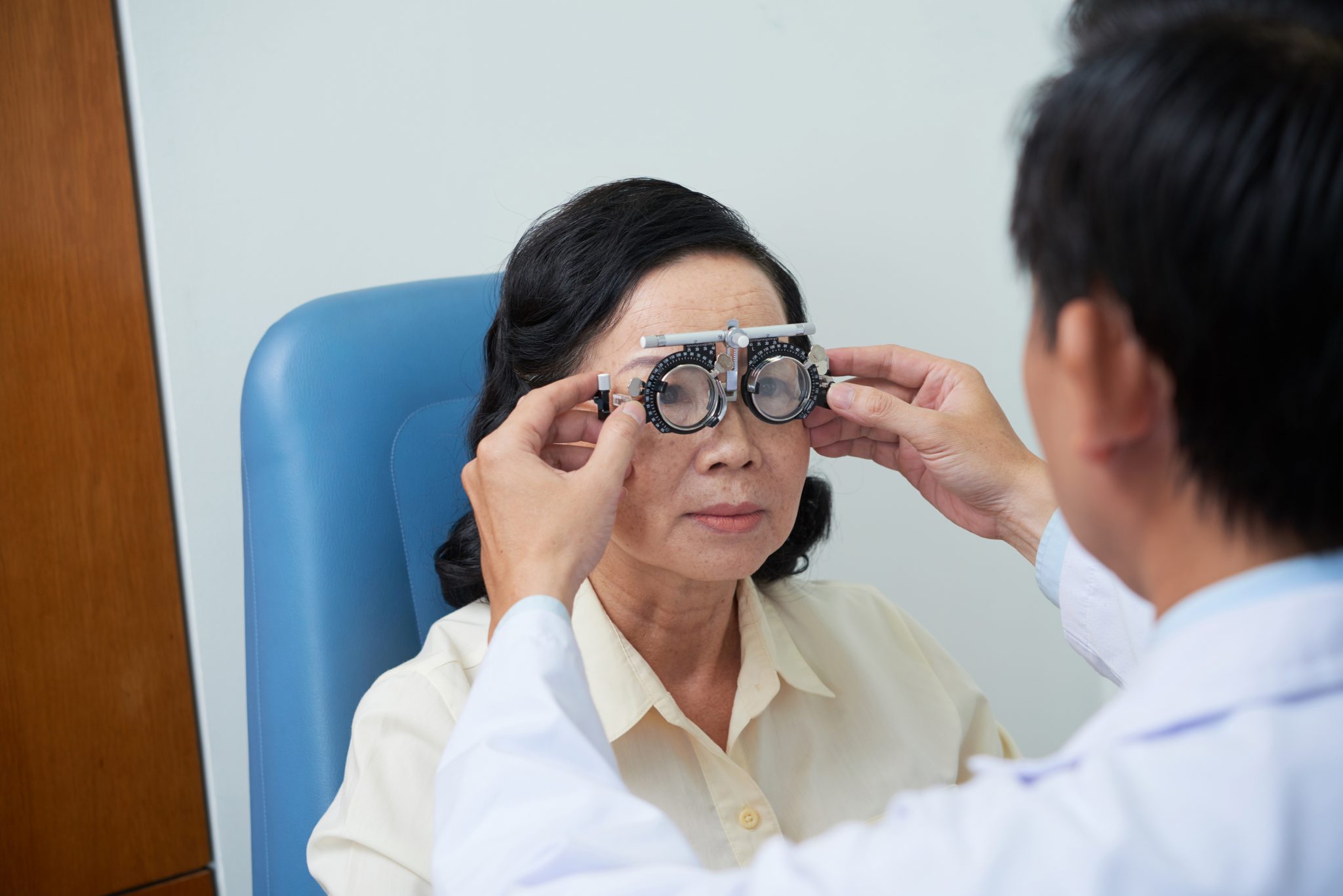Eye exam for diabetes patients in Georgetown is more than just a routine check-up — it’s a critical component of managing your long-term health. Living with diabetes involves more than just controlling your blood sugar; it requires comprehensive medical care to prevent complications, especially those that affect your vision. Regular eye exams can detect diabetic eye diseases early, helping you avoid permanent damage and maintain your quality of life.
Living with diabetes involves more than just managing blood sugar levels—it requires vigilant attention to your entire body, including your eyes. For residents of Georgetown, Ontario, scheduling a regular eye exam for diabetes patients in Georgetown is one of the most important steps in preventing vision loss. At Family Optical, we believe that knowledge empowers our patients to make informed decisions about their healthcare journey.
In this comprehensive guide, we’ll explore the vital relationship between diabetes and vision health, explain why regular diabetic eye exam for diabetes patients in Georgetown are non-negotiable for diabetes management, and provide practical advice for protecting your sight for years to come.
Helpful Resource: Learn more about diabetic eye diseases from the National Eye Institute
The Diabetes-Vision Connection: Understanding the Risks
How Diabetes Affects Your Eyes
Diabetes is fundamentally a disease that affects how your body processes glucose (blood sugar). When glucose levels remain consistently elevated, they can damage the delicate blood vessels throughout your body—including the intricate network of vessels in your eyes. That’s why a regular eye exam for diabetes patients in Georgetown is essential for detecting early signs of vision-related complications and preventing long-term damage.
Over time, this damage can lead to several serious eye conditions:
Diabetic Retinopathy: This progressive condition damages the blood vessels in the retina, the light-sensitive tissue lining the back of your eye. In advanced stages, new, abnormal blood vessels grow on the retina’s surface. These vessels are fragile and can leak, causing vision distortion and potentially blindness if left untreated.
Diabetic Macular Edema (DME): This occurs when fluid accumulates in the macula (the central part of the retina responsible for sharp, straight-ahead vision), causing it to swell and distort vision. DME can develop at any stage of diabetic retinopathy and requires prompt treatment.
Cataracts: While cataracts commonly develop with age, people with diabetes tend to develop them earlier and progress faster. These cloudy areas in the eye’s lens blur vision and increase sensitivity to glare.
Glaucoma: This group of eye conditions damages the optic nerve, often due to abnormally high pressure inside the eye. People with diabetes have nearly double the risk of developing glaucoma compared to those without diabetes.
Risk Factors: Who Needs to Be Most Vigilant?
While all diabetes patients face increased risk for eye complications, certain factors can elevate your risk profile:
- Duration of diabetes: The longer you’ve had diabetes, the higher your risk for developing eye complications.
- Poor blood glucose control: Consistently high A1C levels significantly increase your risk.
- High blood pressure and cholesterol: These conditions compound the damage to blood vessels throughout the body, including the eyes.
- Pregnancy: Hormonal changes during pregnancy can sometimes accelerate diabetic eye disease progression.
- Smoking: Tobacco use restricts blood flow, exacerbating diabetes-related complications.
- Ethnicity: Some studies suggest that people of African, Hispanic, or Indigenous descent may have higher risks for diabetic eye disease.
Understanding these risk factors helps you and your healthcare team develop a personalized approach to eye health monitoring and diabetes management.
The Biology Behind Vision Loss in Diabetes
To truly appreciate why an eye exam for diabetes patients in Georgetown is so crucial, it helps to understand the biological mechanisms at work. When blood glucose levels remain elevated over time, the tiny blood vessels that nourish the retina undergo significant changes:
- Early damage: High glucose weakens vessel walls, causing microaneurysms (tiny bulges) to form.
- Leakage: These damaged vessels begin to leak fluid and blood into the retina.
- Swelling: Accumulated fluid causes swelling in the macula, distorting central vision.
- Oxygen deprivation: As vessels close off, parts of the retina become oxygen-deprived.
- New vessel growth: The eye attempts to compensate by growing new blood vessels, but these are weak and prone to bleeding.
- Scar tissue: Eventually, scar tissue forms, which can pull on the retina and cause detachment.
What makes this process particularly dangerous is that it often progresses silently. Many patients don’t notice symptoms until significant damage has already occurred—which is precisely why regular eye exams for diabetes patients in Georgetown are essential for early detection and intervention.
Why Regular Eye Exams for Diabetes Patients in Georgetown Are Essential
Early Detection: The Key to Preserving Vision
The most compelling reason for regular eye exam for diabetes patients in Georgetown is simple: early detection saves sight. Most diabetic eye conditions progress without noticeable symptoms until they reach advanced stages. By then, treatment options may be limited, and some vision loss may be permanent.
Professional eye exam for diabetes patients in Georgetown can detect changes years before you would notice any symptoms. This early intervention window makes all the difference in treatment outcomes. Studies consistently show that early detection and treatment of diabetic eye disease reduce the risk of severe vision loss by more than 90%.
What to Expect from an Eye Exam for Diabetes Patients in Georgetown
A comprehensive diabetic eye exam for diabetes patients in Georgetown at Family Optical involves several specialized components:
1. Thorough Health History
Your optometrist will begin by discussing:
- Your diabetes history, including diagnosis date and type
- Recent A1C readings and blood glucose control
- Medications you’re currently taking
- Other health conditions that might impact eye health
- Family history of eye diseases
- Any vision changes or symptoms you’ve noticed
This information helps provide context for your exam and guides the optometrist’s approach.
2. Visual Acuity Assessment
Standard vision testing measures how clearly you can see at various distances. This establishes a baseline for your vision and tracks changes over time.
3. Pupil Dilation
Eye drops will be administered to dilate (widen) your pupils. This crucial step allows the optometrist to see the retina, optic nerve, and blood vessels at the back of your eye in detail. While temporarily causing light sensitivity and blurry near vision, dilation provides the most comprehensive view of your eye health.
4. Advanced Retinal Imaging
At Family Optical in Georgetown, we utilize state-of-the-art imaging technology to document the condition of your retina:
- Optical Coherence Tomography (OCT): This non-invasive technology uses light waves to create detailed cross-sectional images of your retina, measuring its thickness and detecting subtle changes invisible to the naked eye.
- Fundus Photography: High-resolution photos of the retina provide a visual record that can be compared over time to track even minor changes.
- Fluorescein Angiography: Sometimes recommended for more advanced cases, this test uses a special dye to highlight blood flow through retinal vessels, pinpointing areas of blockage or leakage.
5. Intraocular Pressure Testing
This quick, painless test measures the pressure within your eye—elevated pressure can indicate glaucoma, which occurs more frequently in people with diabetes.
6. Comprehensive Eye Examination
Your optometrist will thoroughly examine all structures of your eye, paying particular attention to signs of diabetic changes.
7. Personalized Consultation
After your examination, your optometrist will:
- Explain all findings in detail
- Show you images of your eyes and highlight any areas of concern
- Discuss treatment recommendations if needed
- Outline a follow-up schedule based on your specific risk factors
- Answer any questions you have about your eye health
How Often Should You Have a Diabetic Eye Exam?
The Canadian Diabetes Association and most eye care professionals recommend the following schedule:
- Type 1 Diabetes: Annual eye exams beginning five years after diagnosis
- Type 2 Diabetes: Annual eye exams beginning immediately upon diagnosis
- Gestational Diabetes: Eye exam during pregnancy as recommended by your healthcare provider
- Children with Diabetes: Annual exams typically beginning at age 10 or after puberty begins, whichever comes first
However, these are general guidelines. Your optometrist may recommend more frequent exams if:
- You show signs of diabetic eye disease
- Your blood sugar control has been inconsistent
- You have additional risk factors like high blood pressure
- You’re pregnant
- You’ve had diabetes for many years
Why Choose Family Optical for Eye Exams for Diabetes Patients in Georgetown
When it comes to managing eye exam for diabetes patients in Georgetown, having a trusted local provider makes all the difference. Family Optical has established itself as Georgetown’s premier destination for comprehensive diabetic eye care for several compelling reasons:
Specialized Expertise in Diabetic Eye Care
Our optometrists have extensive experience and specialized training in detecting and managing diabetic eye conditions. We understand the unique challenges faced by people with diabetes and tailor our approach accordingly.
State-of-the-Art Diagnostic Equipment
Early detection requires advanced technology. At Family Optical, we’ve invested in cutting-edge diagnostic equipment specifically designed to detect the earliest signs of diabetic eye changes—often before symptoms appear.
Collaborative Care Approach
We believe in a team approach to diabetes management. With your permission, we coordinate with your family physician, endocrinologist, and other healthcare providers to ensure comprehensive care. This integrated approach leads to better outcomes and more personalized treatment plans.
Convenient Georgetown Location
Located in the heart of Georgetown, our practice offers easy access for regular check-ups—a crucial factor in maintaining consistent eye care. Regular monitoring shouldn’t be a burden, and our central location makes it convenient to prioritize your eye health.
Community-Focused Care
As a locally owned and operated practice, we’ve built lasting relationships with Georgetown families over many years. We understand the unique needs of our community and are committed to providing compassionate, personalized care to every patient who walks through our doors.
OHIP Coverage for Diabetic Eye Exams
For Ontario residents diagnosed with diabetes, annual eye examinations are covered by OHIP, regardless of age. Our staff can help you navigate insurance and coverage questions to ensure you receive the care you need.
Proactive Steps for Protecting Your Vision With Diabetes
While regular diabetic eye exam for diabetes patients in Georgetown are essential, what you do between appointments significantly impacts your eye health. Here are practical strategies for protecting your vision when living with diabetes:
1. Maintain Optimal Blood Sugar Control
Keeping your blood glucose levels within target range is the single most effective way to prevent diabetic eye complications. Research consistently shows that tight glucose control can reduce the risk of developing retinopathy by up to 76%.
- Work with your healthcare team to establish target ranges
- Monitor your blood glucose regularly
- Take medications as prescribed
- Adjust your management plan as needed with guidance from your healthcare providers
2. Control Blood Pressure and Cholesterol
High blood pressure and elevated cholesterol compound the risk for eye complications in people with diabetes.
- Have regular check-ups to monitor these levels
- Take prescribed medications consistently
- Adopt heart-healthy lifestyle habits
- Limit sodium intake to help control blood pressure
3. Embrace Eye-Healthy Nutrition
Certain nutrients play a vital role in eye health. Focus on incorporating:
- Dark leafy greens (spinach, kale, collards) rich in lutein and zeaxanthin
- Cold-water fish (salmon, tuna, sardines) high in omega-3 fatty acids
- Colorful fruits and vegetables packed with antioxidants (especially orange and yellow varieties for vitamin A)
- Nuts and seeds containing vitamin E and healthy fats
- Citrus fruits and berries for vitamin C
4. Stay Physically Active
Regular exercise improves insulin sensitivity and promotes better circulation—including blood flow to your eyes. Aim for at least 150 minutes of moderate activity weekly, with your doctor’s approval.
5. Avoid Tobacco and Excessive Alcohol
Smoking damages blood vessels and accelerates nearly all diabetic complications, including eye disease. If you smoke, seeking help to quit is one of the most important steps you can take for your eye health.
6. Wear Protective Eyewear
Shield your eyes from UV damage with quality sunglasses that block 100% of UVA and UVB rays, even on cloudy days. This protection helps prevent cataracts and macular degeneration.
7. Know the Warning Signs
While early-stage diabetic eye disease often has no symptoms, being aware of potential warning signs can help you seek care promptly if they appear:
- Blurry or fluctuating vision
- Dark spots or “floaters” in your field of vision
- Flashes of light
- “Holes” or blank spots in your vision
- Difficulty with color perception
- Poor night vision
- Sudden vision loss in one or both eyes
Remember: By the time symptoms appear, some damage may have already occurred. This reinforces why regular diabetic eye exam for diabetes patients in Georgetown are so crucial—they catch problems before symptoms develop.
Frequently Asked Questions About Diabetic Eye Care
Is diabetic retinopathy reversible?
In its early stages, improving blood sugar control and appropriate treatment can sometimes reverse mild diabetic retinopathy or prevent further progression. However, advanced retinopathy with significant damage is generally not reversible, though treatments can prevent additional vision loss. This highlights the importance of early detection through regular diabetic eye exam for diabetes patients in Georgetown.
Will I need dilation at every eye exam?
Yes, pupil dilation is essential for a thorough diabetic eye exam for diabetes patients in Georgetown. It’s the only way your optometrist can fully examine the retina and detect early signs of diabetic eye disease.
How can I prepare for my diabetic eye exam?
- Bring your current glucose meter and recent A1C results
- Make a list of all medications you’re taking
- Note any vision changes you’ve experienced
- Bring sunglasses for after-dilation comfort
- Arrange for someone to drive you home if you’re concerned about driving with dilated pupils
- Allow 1–2 hours for a comprehensive exam
I have perfect vision—do I still need an eye exam?
Absolutely. The earliest stages of diabetic eye disease often cause no vision changes or symptoms. Even if you have 20/20 vision, regular exams can detect issues early when treatment is most effective.
How is diabetic retinopathy treated?
- Early stages: Often monitored with improved blood sugar control
- Advanced stages: May require laser treatment, anti-VEGF injections, or surgery
Are children with diabetes at risk for eye problems?
Yes. Children with diabetes can develop the same complications as adults. The Canadian Diabetes Association recommends annual eye exams for children starting at age 10 or five years after diagnosis—whichever comes first.
Can stress affect diabetic eye health?
Yes. Stress can raise blood sugar levels, making glucose control more difficult and increasing the risk of eye complications. Managing stress is key to protecting your vision.
Conclusion: Your Vision is Worth Protecting
Living with diabetes presents unique challenges, but vision loss doesn’t have to be one of them. With proactive care, regular exams, and experienced professionals, you can preserve your sight and maintain your quality of life.
At Family Optical in Georgetown, we’re dedicated to providing the best care for diabetes patients. Our comprehensive approach combines advanced technology with compassionate, personalized attention to protect your most precious sense—your vision.
Don’t wait until symptoms appear. Schedule your diabetic eye exam in Georgetown today. Your future self will thank you.
Book Your Diabetic Eye Exam Today
Take control of your eye health by scheduling your exam at Family Optical.
Family Optical Georgetown
Visit our website: https://familyoptical.ca
Call us: (905) 873-3050





